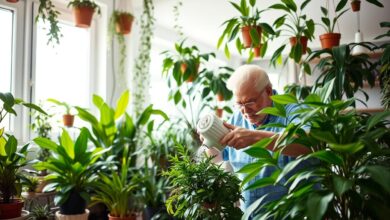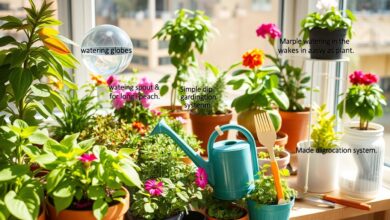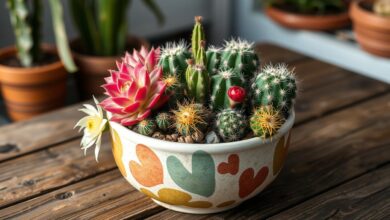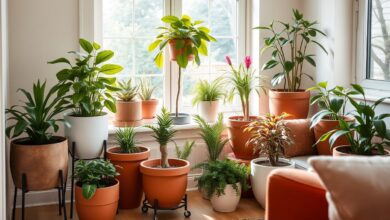Easy Gardening for Seniors: Tips and Tricks
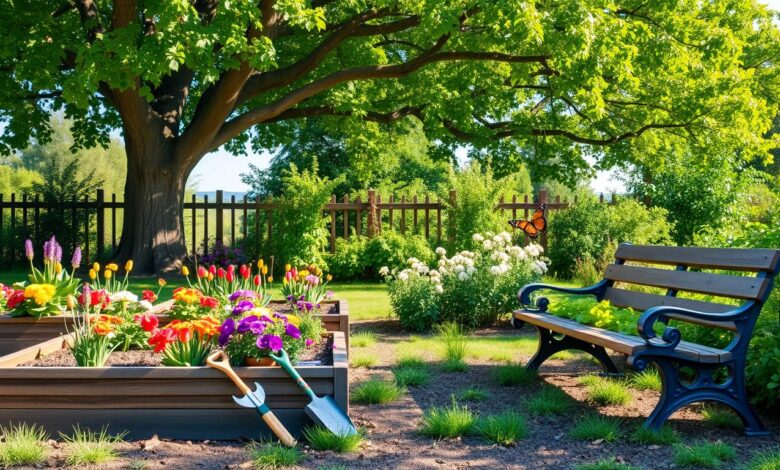
No matter your age or the color of your thumb, gardening is a wonderful hobby that provides numerous benefits for mind, body and spirit. Whether you’ve planted a thousand seeds and grown all your own food, or you’ve never touched a trowel, there are ways to make growing your own flowers and vegetables simple and attainable. This article will provide tips and tricks for easy gardening for seniors.
Studies have shown that stretching before gardening can reduce the risk of injuries by up to 25%, and staying hydrated while gardening can reduce the likelihood of dehydration by 40%. Gardening with a partner can also improve safety by 50% compared to gardening alone. Raised garden beds can reduce bending and kneeling by 75% for seniors, while using gardening tools designed for seniors can decrease the risk of strain or injury by 30%.
Choosing low-maintenance plants can reduce gardening time by up to 50%, and using appropriate tools for gardening tasks in place of manual labor can save seniors up to 40% of physical effort. Having assistance for difficult tasks can also decrease physical strain by 35%, and a positive attitude can contribute to reducing stress levels by up to 20%.
Table of Contents
Introduction to Gardening for Seniors
Gardening has long been recognized for its therapeutic benefits, and it holds particular significance for seniors. Engaging in gardening for seniors is not just a hobby or pastime; it is a fulfilling and meaningful activity that can enhance their overall well-being. The therapeutic benefits of gardening extend beyond the joy of nurturing plants, including physical health, mental well-being, cognitive stimulation, social interaction, and a sense of purpose.
The Therapeutic Power of Gardening
Many seniors find purpose, accomplishment, and joy in gardening activities, which can have a profound impact on their senior wellness. Gardening provides a sense of control and autonomy, allowing seniors to nurture their plants and witness the fruits of their labor. This sense of achievement can boost self-esteem and contribute to a heightened sense of well-being.
Benefits of Gardening for Seniors
- Promotes physical health by improving flexibility, strength, and cardiovascular health.
- Positively impacts mental health, reducing stress, anxiety, and depression.
- Provides cognitive stimulation, potentially reducing the risk of cognitive decline.
- Offers opportunities for social interaction, combating feelings of isolation.
- Gives seniors a sense of purpose, accomplishment, and boosts self-esteem.
By incorporating gardening for seniors into their lifestyle, older adults can experience the profound therapeutic benefits of gardening and enhance their overall senior wellness.
Creating an Accessible Garden
Designing a senior-friendly garden is crucial for making gardening a pleasurable and accessible activity for older adults. By incorporating accessible garden features, seniors can fully enjoy the therapeutic benefits of gardening. Key aspects to consider include wide and level garden paths, raised garden beds, comfortable garden seating, and the use of adaptive gardening tools, grip aids, and clear garden labels.
Designing a Senior-Friendly Garden
To create a senior-friendly garden, start by ensuring that the garden layout is easy to navigate. Opt for wide, level garden paths that allow for smooth wheelchair or walker access. Raised garden beds placed at a comfortable height can make gardening tasks more accessible for seniors with limited mobility. Additionally, incorporate comfortable garden seating areas where they can rest and enjoy the tranquility of the garden.
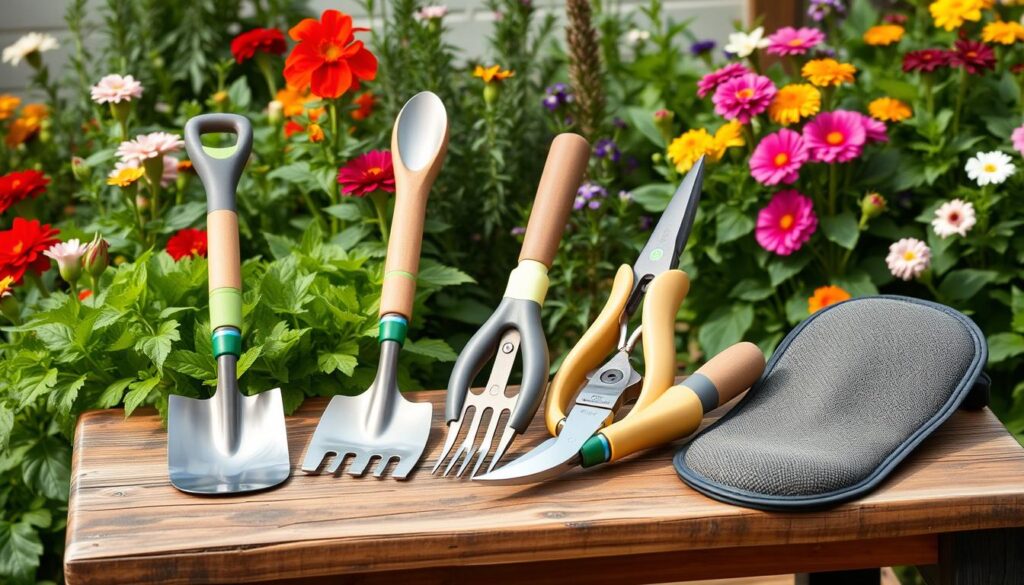
Adaptations and Modifications
- Utilize adaptive gardening tools with brightly colored, grip aids to assist seniors with vision impairments or reduced dexterity.
- Employ clear, legible garden labels to help seniors easily identify plants and garden features.
- Consider installing a ratchet pulley system for hanging containers, allowing seniors to lower and raise the containers with ease.
- Opt for container gardening with casters or stands for improved mobility and accessibility.
| Accessible Garden Feature | Benefit |
|---|---|
| Wide, level garden paths | Smooth wheelchair and walker access |
| Raised garden beds | Easier for seniors to reach and tend |
| Comfortable garden seating | Allows for rest and enjoyment of the garden |
| Adaptive gardening tools with grip aids | Assists seniors with vision impairments and reduced dexterity |
| Clear, legible garden labels | Helps seniors easily identify plants and features |
Best Plants for Senior Gardens
Gardening can be a rewarding and therapeutic activity for seniors, and selecting the right plants is crucial to ensure a low-maintenance and enjoyable experience. From low-maintenance options to plants with sensory appeal, the right choices can transform a garden into a serene oasis.
Low-Maintenance Plants
When it comes to gardening for seniors, opting for plants that require minimal watering, pruning, and fertilization can make a significant difference. Lavender, sedum, hosta, daylily, and rosemary are all excellent choices for low-maintenance senior gardens. These plants thrive with little intervention, allowing seniors to relax and savor the beauty of their outdoor spaces.
Plants with Sensory Appeal
In addition to low-maintenance options, plants with sensory appeal can enhance the gardening experience for seniors. Lamb’s ear, chocolate cosmos, lemon balm, and mint engage the senses of touch, smell, and taste, providing a multisensory connection with nature. These plants can inspire moments of calm and delight, contributing to the overall therapeutic benefits of gardening.
| Plant | Sensory Appeal | Maintenance Requirements |
|---|---|---|
| Lavender | Fragrant, Soothing | Low Water, Drought-Tolerant |
| Sedum | Textural, Succulent | Minimal Watering, Pest-Resistant |
| Hosta | Lush Foliage | Shade-Tolerant, Low Maintenance |
| Daylily | Vibrant Flowers | Drought-Tolerant, Hardy |
| Rosemary | Aromatic, Culinary | Drought-Resistant, Low Watering |
| Lamb’s Ear | Soft, Velvety Leaves | Drought-Tolerant, Low Maintenance |
| Chocolate Cosmos | Chocolate-Scented Blooms | Full Sun, Minimal Watering |
| Lemon Balm | Refreshing Citrus Aroma | Spreads Readily, Drought-Tolerant |
| Mint | Fragrant, Edible Leaves | Grows Vigorously, Needs Containment |
Gardening Tools and Equipment
To ensure a comfortable and enjoyable gardening experience for seniors, it’s essential to choose the right tools and equipment. Ergonomic gardening tools are specifically designed to reduce strain and discomfort, featuring cushioned handles, lightweight designs, and adjustable lengths. In addition to these ergonomic gardening tools, assistive devices such as garden carts, soaker hoses, and drip irrigation systems can further enhance the gardening experience for seniors by reducing physical effort and strain.
Choosing Ergonomic Tools
As seniors age, their hands can become weaker and less flexible, making traditional gardening tools challenging to use. Manufacturers are now offering ergonomically designed gardening tools crafted to fit comfortably in the hand and made from lightweight, durable materials. Investing in high-quality garden tools can lead to seldom needing replacements due to wear and tear, providing long-lasting value.
Utilizing Assistive Devices for Gardening
In addition to ergonomic gardening tools, assistive devices such as garden carts, soaker hoses, and drip irrigation systems can greatly improve the gardening experience for seniors. These tools can help reduce physical strain and effort, allowing seniors to enjoy their gardens with greater ease and comfort.
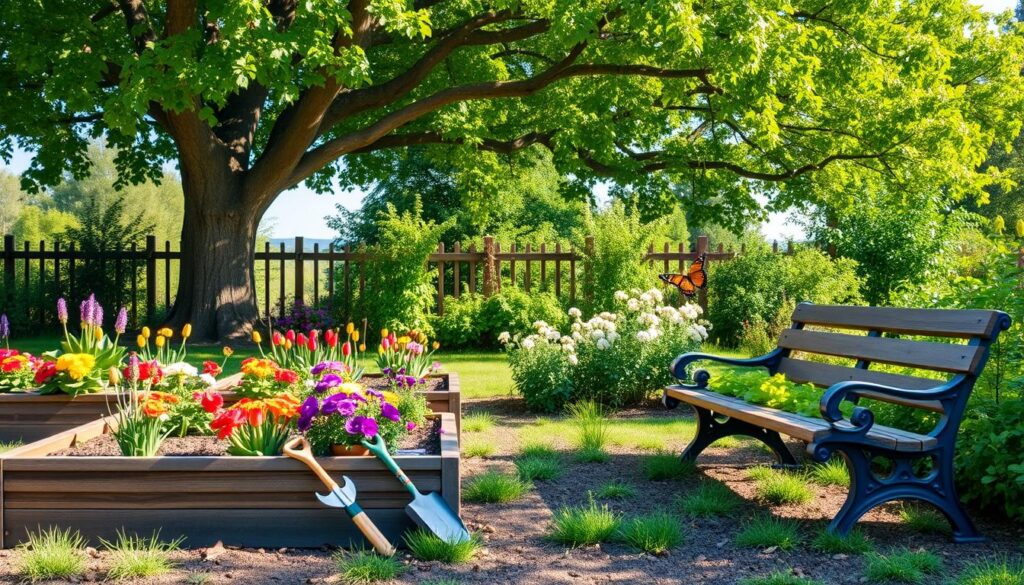
By incorporating both ergonomic gardening tools and assistive devices into their gardening routine, seniors can maintain their passion for gardening and reap the numerous benefits it provides, from physical activity to mental wellbeing.
Raised Garden Beds for easy gardening for seniors
For seniors seeking a more comfortable and accessible gardening experience, raised garden beds are a game-changer. By elevating the planting area to a comfortable height, these beds eliminate the need for bending and kneeling, making gardening tasks more manageable for older adults.
The ideal raised garden bed for seniors should be between 24 and 30 inches high, allowing easy access to plants without excessive strain on the back and joints. A width of around 4 feet provides ample space for comfortable reach from all sides. Cedar timber is a popular choice due to its durability, rot-resistance, and insect-repellent properties, and most cedar raised beds can be assembled within a few hours.
Raised garden beds offer numerous benefits for seniors, including better soil drainage, reduced soil compaction, and the ability to customize the growing environment to individual needs and preferences. These beds can be moved or modified easily, providing warmer soil in winter and cooler temperatures in summer, enabling year-round vegetable growth.
For seniors with limited space, small raised garden beds, such as herb gardens or salad tables, can maximize yield while minimizing the physical effort required. Wheelchair-accessible raised beds can also be designed to cater to individuals with mobility challenges.
When setting up raised garden beds, it’s essential to consider factors like proper drainage, weed control, and the use of ergonomic gardening tools and accessories. With a bit of planning and the right setup, raised beds can transform the gardening experience for seniors, making it more enjoyable, manageable, and rewarding.
Containers and Vertical Gardening
For seniors with limited space or mobility, container gardening and vertical gardening offer convenient and accessible options. Growing plants in pots, planters, and hanging baskets allows seniors to enjoy the benefits of patio gardening without the need for extensive ground-level garden beds. Container and vertical gardening also enable seniors to cultivate a variety of easy-to-grow container plants, such as potted herbs, flowers, and small vegetables, right on their patio or balcony.
Vertical gardening, in particular, maximizes gardening space and can complement traditional gardening methods. Seniors can create affordable, DIY trellises and supports using materials like welded wire, T-posts, and repurposed items such as old bed frames or window frames. These structures allow them to grow climbing plants like beans, peas, cucumbers, melons, squashes, and tomatoes vertically, saving valuable ground space.
| Item | Approximate Cost |
|---|---|
| 80-inch vertical gardening trellis | $35 |
| Welded wire, 600 inches (3′ x 50′) | $35 |
| T-posts | $4 each |
| Arched trellis made from cattle panels | $30 |
| Coated poultry netting, 25 feet | $20 |
By incorporating container gardening and vertical gardening techniques, seniors can enjoy the therapeutic benefits of gardening while overcoming the challenges of limited space and mobility. With a bit of creativity and the right tools, they can cultivate a thriving and productive senior-friendly garden on their patio or balcony.
Adaptive Gardening Techniques
As we age, physical limitations can make traditional gardening tasks increasingly challenging. However, with the right adaptive techniques and ergonomic methods, seniors can continue to enjoy the therapeutic benefits of gardening while minimizing the risk of injury or discomfort. By incorporating these strategies, seniors can cultivate their green spaces in a way that suits their needs and abilities.
Ergonomic Gardening Methods
One of the keys to adaptive gardening for seniors is the use of ergonomic tools and equipment. Garden tools for arthritis and garden tools for limited mobility can make a significant difference in the comfort and ease of gardening tasks. Some recommended options include:
- Lightweight, cushioned grip tools to reduce strain on the hands and wrists
- Long-handled tools that minimize bending and stooping
- Electric or battery-operated tools, such as tillers and trimmers, to assist with heavier tasks
- Portable, foldable seats or stools to provide comfortable resting spots throughout the garden
In addition to specialized tools, adopting proper ergonomic gardening techniques can make a significant difference. This includes pacing oneself, taking regular breaks, and utilizing proper lifting and bending techniques to protect the back and joints.
By incorporating these adaptive gardening for seniors strategies, older adults can continue to reap the physical, mental, and emotional benefits of gardening for years to come.
Low-Impact Gardening Activities
For seniors with limited mobility or physical constraints, low-impact gardening activities can provide a fulfilling and accessible way to engage with nature. These gentle activities, such as seated gardening, container planting, and light weeding, allow seniors to participate in gardening without the need for strenuous physical exertion.
By focusing on gentler gardening tasks and making thoughtful modifications, seniors can continue to derive the therapeutic benefits of gardening while prioritizing their comfort and safety. This approach to low-impact gardening for seniors ensures that they can maintain their passion for gardening, even with age-related physical limitations.
Gentle Gardening Activities for Seniors
- Seated gardening using raised planters or table-top gardens
- Container gardening with lightweight pots and planters
- Lightweight hand weeding and light pruning tasks
- Watering plants from a seated position
- Propagating plants from cuttings or seeds
Gardening Modifications for Limited Mobility
- Utilize ergonomic gardening tools with long handles and cushioned grips
- Invest in a garden scooter or rolling garden seat for easy mobility
- Incorporate raised garden beds to minimize bending and stretching
- Choose low-maintenance plants that require less frequent care
- Opt for container gardening or vertical gardening solutions
By embracing these low-impact gardening activities and making strategic adaptations, seniors can continue to reap the mental, physical, and social benefits of gardening, even with age-related limitations. These gentle gardening techniques empower seniors to stay active, connected, and fulfilled in their golden years.
| Low-Impact Gardening Activities | Benefits for Seniors |
|---|---|
| Seated Gardening | Reduces physical strain, allows for continued engagement |
| Container Gardening | Minimizes bending and stretching, enables mobility |
| Light Weeding and Pruning | Provides light exercise, improves dexterity |
| Ergonomic Gardening Tools | Reduce strain on hands and wrists, make tasks easier |
| Raised Garden Beds | Eliminate bending, enable gardening from a seated position |
Gardening for Seniors with Limited Mobility
Gardening offers numerous benefits for seniors, but those with limited mobility may face unique challenges. However, with the right adaptations and assistive devices, gardening can remain an accessible and rewarding hobby for older adults.
For seniors with reduced mobility, container gardening is an effective solution. Planting in pots or boxes eliminates the need for bending or kneeling, making it easier to tend to plants. Raised bed gardening is another accessible alternative, as the elevated beds reduce the strain on joints and muscles.
Indoor plants can also provide a convenient gardening option for seniors who find it difficult to venture outside. These low-maintenance options allow older adults to enjoy the therapeutic effects of nature without the physical demands of traditional gardening.
To further enhance the gardening experience for seniors with limited mobility, ergonomically designed tools can make tasks less physically demanding. Gardening tools with longer handles, cushioned grips, and lightweight designs can significantly improve ease of use and reduce strain on the body.
By incorporating these adaptations and utilizing mobility aids, such as garden carts, stools, and powered scooters, seniors with limited mobility can continue to reap the benefits of gardening, including improved physical and mental well-being.
| Gardening Solution | Benefits for Seniors with Limited Mobility |
|---|---|
| Container Gardening | Eliminates the need for bending or kneeling, making it easier to tend to plants. |
| Raised Bed Gardening | Elevated beds reduce strain on joints and muscles, providing an accessible alternative. |
| Indoor Plants | Offer a convenient gardening option for seniors who find it challenging to go outside. |
| Ergonomic Gardening Tools | Designed with features like longer handles and cushioned grips to make tasks less physically demanding. |
Community Gardens and Social Gardening
Gardening can be a rewarding social activity, providing opportunities for seniors to connect with others who share their passion for horticulture. Joining community gardens, gardening clubs, or attending workshops can foster meaningful interactions and combat feelings of isolation that sometimes accompany the golden years.
These community-based gardening initiatives not only allow seniors to engage in a fulfilling hobby but also facilitate the development of social connections and a sense of belonging within the local community. Studies show that gardening activities help lower blood pressure, improve memory, and enhance physical and mental well-being among older adults.
Many senior living communities, such as Lutheran Senior Services (LSS) and Lutheran Hillside Village, provide on-site gardens or organized gardening programs for residents to enjoy the therapeutic benefits of community gardens for seniors and social gardening. These programs promote gardening workshops and gardening clubs that encourage seniors to socialize, learn new skills, and stay active.
Beyond senior living communities, community gardens are increasingly accessible in cities across the United States. For example, the Denver metropolitan area boasts over 180 community gardens through Denver Urban Gardens (DUG), catering to diverse neighborhoods and fostering a sense of community involvement.
Participation in community gardening can significantly impact the overall well-being of seniors by providing opportunities for physical activity, mental stimulation, and meaningful social interactions. Gardening clubs and local gardening organizations, such as the Colorado Native Plant Society, also offer unique avenues for seniors to connect with like-minded individuals and share their love for horticulture.
| Benefits of Community Gardening for Seniors | Impact on Seniors’ Well-being |
|---|---|
| Improved physical health through moderate exercise Enhanced mental and emotional well-being Stronger social connections and reduced isolation Opportunities to learn new skills and share knowledge Increased exposure to nature and vitamin D | Lowered blood pressure and improved cardiovascular health Better memory and cognitive function Reduced stress and improved mood Increased mobility, flexibility, and overall physical fitness Strengthened sense of purpose and belonging within the community |
Therapeutic Horticulture Programs
Therapeutic horticulture programs are designed to harness the therapeutic benefits of gardening for older adults, particularly those facing mental health challenges or cognitive decline. These programs involve structured gardening activities, guided by trained professionals, to promote relaxation, cognitive stimulation, and overall well-being. By participating in therapeutic horticulture programs, seniors can experience the restorative power of nature and engage in a meaningful, therapeutic activity.
Research indicates that gardening can change patterns of behavior in individuals with dementia, showing reductions in aggressive behavior, pacing, trespassing, and incontinence. Therapeutic horticulture programs are recognized by healthcare professionals for their therapeutic effects on elderly, ill, and disabled individuals. These programs involve using plant materials to help clients maintain and enhance physical skills and mobility, fostering a sense of usefulness and hope in patients.
Interaction with plants in therapeutic horticulture settings encourages cooperative efforts and reduces feelings of isolation among disabled individuals. Therapeutic horticulture is utilized in various settings such as schools, extended care facilities, Alzheimer’s units, and treatment centers, providing a range of benefits for seniors, including improved mood, memory, attention, confidence, cognitive abilities, language skills, ability to take on new tasks, socialization, sleep, and quality of life.
Senior living communities are recognizing the benefits of therapeutic gardens in providing a more meaningful life for residents. Kensington Park, for instance, offers a garden club for its assisted living residents, focusing on different activities in each season, including planting seeds, growing fresh vegetables and herbs, and harvesting, culminating in preparing fresh dishes and shared meals. Therapeutic horticulture programs are a valuable resource for seniors seeking to improve their mental health, cognitive function, and overall well-being.
Safety Tips for Senior Gardeners
Gardening is a beloved pastime for many seniors, offering numerous physical and mental health benefits. However, maintaining safety should be a top priority for older adults engaging in gardening activities. Here are some essential safety tips to ensure senior gardeners can enjoy their time in the garden without risk of injury.
Sun Protection for Seniors
To shield against the sun’s harmful UV rays, senior gardeners should wear wide-brimmed hats, long sleeves, and sunscreen when spending time outdoors. Choosing sun-protective clothing and applying sunscreen regularly can help prevent sunburns and skin damage.
Staying Hydrated
Maintaining proper hydration is crucial, especially for seniors who may be more susceptible to dehydration. Keeping a water bottle within reach and taking regular breaks to drink water can help prevent heat-related illnesses during gardening sessions.
Fall Prevention in the Garden
Uneven paths, loose stones, and other obstacles in the garden can increase the risk of falls for senior gardeners. Maintaining level and clear pathways and using sturdy gardening tools and equipment can help reduce the likelihood of falls and injuries.
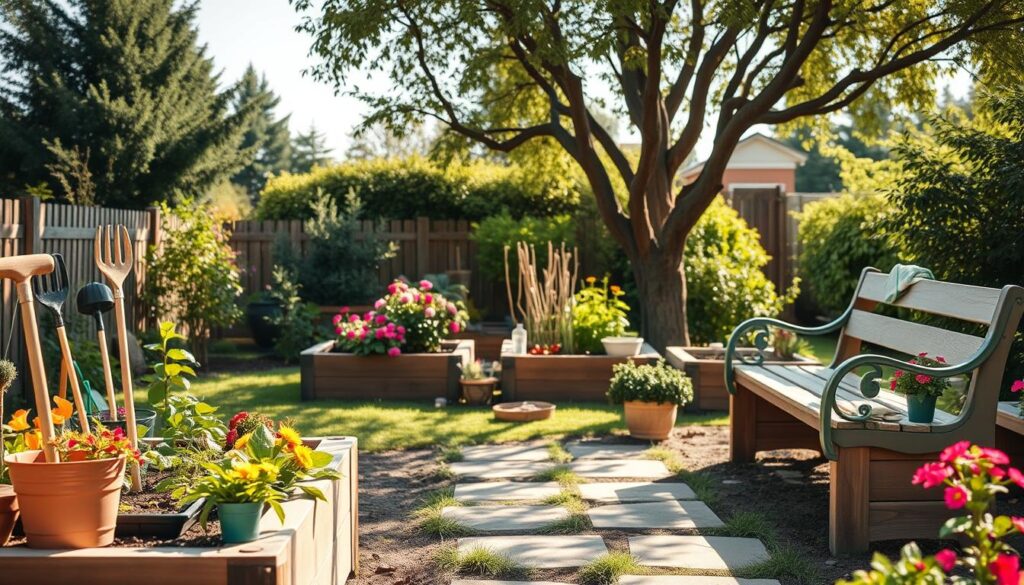
Gardening Safety Gear
Wearing appropriate gloves, knee pads, and comfortable, non-slip shoes can help protect senior gardeners from cuts, scrapes, and other injuries while tending to their plants.
By incorporating these safety tips into their gardening routines, seniors can continue to enjoy the therapeutic benefits of gardening while prioritizing their well-being. Staying vigilant about sun protection, hydration, fall prevention, and using the right safety gear can help senior gardeners create a safe and enjoyable outdoor haven.
Conclusion
Gardening is a rewarding hobby that can provide numerous benefits for seniors, from improved physical health to enhanced mental well-being and social engagement. By incorporating senior-friendly design elements, adaptive tools and techniques, and low-maintenance plant selections, easy gardening for seniors can be made accessible and enjoyable. Whether it’s tending to a raised garden bed, cultivating container plants, or participating in a community gardening initiative, the joy of senior-friendly gardening can be sustained well into the golden years.
By embracing the tips and tricks outlined in this article, seniors can continue to reap the therapeutic rewards of gardening. The positive impacts of this activity, as evidenced by various studies, encompass enhanced flexibility, muscular strength, cardiovascular health, and bone health, as well as reduced stress, anxiety, and dementia risk. Furthermore, the social and cognitive benefits of gardening contribute to an overall improvement in the quality of life for older adults.
As the popularity of gardening continues to grow, with an estimated one in three Americans and 40% of the UK population actively participating, the opportunities for easy gardening for seniors have never been more accessible. By cultivating a senior-friendly garden, utilizing ergonomic tools, and engaging in low-impact gardening activities, retirees can enjoy the countless physical, mental, and social benefits that this rewarding hobby can provide well into their golden years.
FAQ
What are the therapeutic benefits of gardening for seniors?
Gardening has been recognized for its therapeutic benefits, providing seniors with a sense of purpose, accomplishment, and joy. It can enhance their overall well-being by promoting physical health, mental well-being, cognitive stimulation, social interaction, and a sense of purpose.
How can I design a senior-friendly garden?
When designing a senior-friendly garden, consider features such as wide and level pathways, raised garden beds, comfortable seating areas, and the use of adaptive gardening tools, grip aids, and clear labels and signage.
What are some low-maintenance plants suitable for senior gardens?
Ideal plants for senior gardens include lavender, sedum, hosta, daylily, and rosemary, as they require minimal watering, pruning, and fertilization. Plants with sensory appeal, such as those that engage sight, touch, smell, and taste, can also enhance the gardening experience for seniors.
How can I choose the right gardening tools and equipment for seniors?
Ergonomic tools designed to reduce strain and discomfort, with features like cushioned handles, lightweight design, and adjustable lengths, are ideal for senior gardeners. Assistive devices such as garden carts, soaker hoses, and drip irrigation systems can also enhance the gardening experience by reducing physical effort and strain.
What are the benefits of raised garden beds for seniors?
Raised garden beds eliminate the need for bending and kneeling, making gardening tasks more comfortable and manageable for older adults. They can be custom-made to the desired height, size, and style to suit individual needs and preferences, providing a senior-friendly solution for growing flowers, herbs, and vegetables.
How can container and vertical gardening benefit seniors?
Container and vertical gardening offer convenient and accessible options for seniors with limited space or mobility. Growing plants in pots, planters, and hanging baskets allows seniors to enjoy the benefits of gardening without the need for extensive ground-level garden beds, and enables the cultivation of low-maintenance plants right on their patio or balcony.
What are some adaptive gardening techniques for seniors?
Adaptive gardening techniques for seniors include the use of long-handled tools, lightweight and cushioned grips, and other assistive devices that reduce strain on the body and make gardening tasks more manageable. These techniques can help seniors continue to engage in gardening while minimizing the risk of injury or discomfort.
How can seniors with limited mobility enjoy gardening?
Seniors with limited mobility can still enjoy the benefits of gardening by incorporating low-impact activities, such as seated gardening, container planting, and light weeding, as well as utilizing mobility aids like garden carts, stools, and powered garden scooters to navigate the garden and perform gardening tasks.
What are the benefits of community gardening for seniors?
Joining community gardens, gardening clubs, or attending workshops can foster social interaction and combat feelings of isolation for seniors. These community-based gardening initiatives allow seniors to engage in a rewarding hobby while developing social connections and a sense of belonging within the local community.
How can therapeutic horticulture programs benefit senior gardeners?
Therapeutic horticulture programs are designed to harness the therapeutic benefits of gardening for older adults, particularly those facing mental health challenges or cognitive decline. These programs involve structured gardening activities guided by trained professionals to promote relaxation, cognitive stimulation, and overall well-being.
What are some important safety considerations for senior gardeners?
Key safety considerations for senior gardeners include wearing appropriate protective clothing, maintaining hydration, having someone check on the senior gardener periodically or gardening with a partner, and maintaining level and obstacle-free pathways in the garden to prevent falls and accidents.

